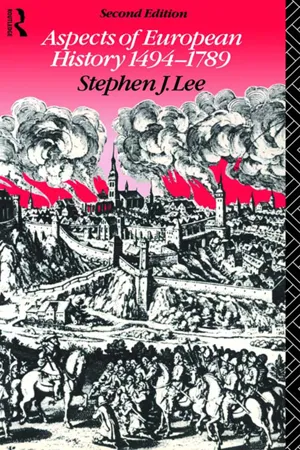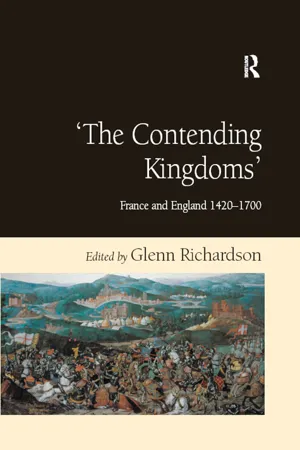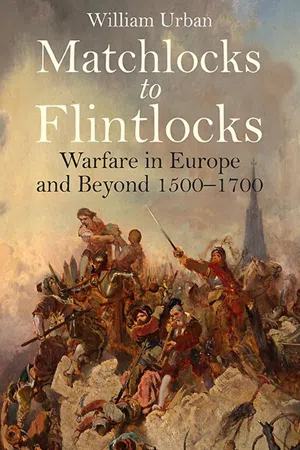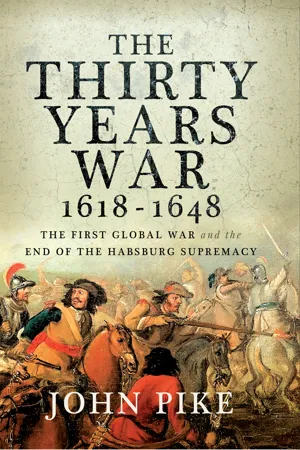History
Treaty of Cateau Cambresis
The Treaty of Cateau-Cambrésis, signed in 1559, marked the end of the Italian Wars. It was a peace treaty between the Habsburg Empire, France, and Spain, and it effectively established the boundaries of their respective territories in Europe. The treaty also brought an end to the long-standing conflict between the Habsburgs and the Valois dynasty in France.
Written by Perlego with AI-assistance
Related key terms
Related key terms
1 of 4
Related key terms
1 of 3
4 Key excerpts on "Treaty of Cateau Cambresis"
- eBook - ePub
- Stephen J. Lee(Author)
- 2005(Publication Date)
- Routledge(Publisher)
The Habsburg forces of Austria and Spain, together with imperial resources, therefore came into increasing conflict with France across an ever widening front in the south and west. There was also a major threat in the east, this time from the Turks. In 1519 Charles succeeded Maximilian as Archduke of Austria, although he handed this title over to his brother Ferdinand in 1521. In 1526 Ferdinand added Bohemia and part of Hungary to the Habsburg dominions, territories which he acquired through his wife Anne, sister of King Lewis of Hungary and Bohemia. Lewis had attempted to stem the advance of the Turks under Suleiman the Magnificent and had been killed at the Battle of Mohacs in 1526. Hungary ceased to exist as an independent state, most of it being absorbed into the Ottoman Empire, the rest going to Austria. Austria was therefore deprived of a vital buffer state between Central Europe and the Turks; and the city of Vienna was now vulnerable to Turkish attack. This conflict was brought within the scope of the Habsburg-Valois struggles by the diplomacy of Francis I. In his efforts to find a way out of his humiliations at Madrid in 1526 and Cambrai in 1529, Francis sought to use the Turkish peril as a means of weakening the Habsburgs by constant attacks from the rear. He therefore urged Suleiman to take Vienna in 1529 and, although the siege failed, Francis formed an open alliance with the Turks in 1536. Francis also succeeded in extending the theatre of war to the Mediterranean. The Sultan agreed to attack Naples; the Turkish admiral, Barbarossa, raided the Italian coastline; and an attempt by Charles V to capture Algiers in 1541 failed. By 1543 the French and Turks virtually controlled the Mediterranean and were sufficiently confident to launch an attack on Nice. The Franco-Turkish Alliance was undoubtedly the main reason for the rapid French recovery after the humiliations of the 1520s and for the increasing success of the anti-Habsburg bloc.The Treaty of Cateau Cambresis (1559) was an acknowledgement of the stalemate reached in the Habsburg-Valois struggles and the terms reflect the relative advantages gained by the combatants at the time. France was to retain Metz, Toul and Verdun but to restore Luxemburg, Savoy and Piedmont; Spain's possessions in Italy were confirmed; Philip II and Henry II agreed to suppress heresy in their dominions; and Philip II was betrothed to Elizabeth, Henry II's daughter.Who gained most from this Treaty? During the 1520s it had appeared that France was in the process of being crushed by a greatly superior power. Yet, by 1559, a treaty had been drawn up between powers acknowledged to be equal in status. The Habsburgs had, therefore, suffered losses since the 1520s. France had begun to make inroads into the Holy Roman Empire, much of Hungary had fallen to the Turks, the Empire had divided itself along religious lines, Charles V had been forced to abdicate and the Habsburg dominions had been divided between Philip II and Ferdinand I. Heavy demands had been made on the wealth and resources of Spain and a dependence on treasure shipments from the New World would shortly amount to addiction, followed by bankruptcy for Spain and economic collapse. Charles V's concept of universal empire was shattered, although Philip II, to his cost, attempted to revive it. France, on the other hand, had gained enormously in power and prestige. Yet she was unable to hammer home the advantages she had earned. The decision to uproot heresy in France precipitated a period of civil war in France which removed any further French threat from the Habsburg territories for the rest of the sixteenth century.The Treaty could not provide a permanent settlement between France and the Habsburgs. It did not dispel France's fear of the Habsburg combination; Richelieu later revived the anti-Habsburg emphasis of French foreign policy, and made use of French gains at Cateau Cambrésis as a means of extending France's frontiers further towards the Rhine. Once Richelieu had destroyed the spectre of Austro-Spanish power by successfully involving France in the Thirty Years’ War, it was left to Mazarin and Louis XIV to complete the destruction of Spanish territory in the Rhine area in a series of wars between France and Spain in the second half of the seventeenth century. The settlement in Italy lasted rather longer; but even so, the Spanish possessions confirmed at Cateau Cambrésis eventually passed to Austria by the Treaty of Utrecht (1713) and then to France after Bonaparte's invasion of Italy in 1796. - eBook - ePub
'The Contending Kingdoms'
France and England 1420–1700
- Glenn Richardson, Glenn Richardson(Authors)
- 2017(Publication Date)
- Routledge(Publisher)
What is more, relations between England and France were undoubtedly tense and problematic over the period when Elizabeth ruled and Catherine enjoyed influence. At Elizabeth’s accession in November 1558, the two realms were still technically at war and a peace treaty between them was only agreed because both Elizabeth and Henry II lacked the resources to continue military action. The treaty of Cateau-Cambrésis, signed in April 1559, did little to settle the important issues in dispute between the two realms; the future of Calais (that relic of the Hundred Years War and England’s last remaining Continental possession until it was captured by the French in January 1558), French influence in Scotland, and the claim of Henry’s daughter-in-law, Mary Queen of Scots, to the English throne all remained matters in contention and were soon to result in further military conflict. Furthermore, confessional differences helped drive a deeper wedge between the two governments. Elizabeth and her leading councillors were convinced that first Henry, and then the new king, Francis II, would agitate for a papal bull of excommunication and take the lead in a crusade to depose Elizabeth and replace her with the Catholic Mary Queen of Scots. While exaggerated, these anxieties were not without foundation until Francis died in December 1560. Afterwards, however, they came to border on paranoia, not least because the French were far too busy tearing their own realm apart to be in a position to mount an invasion of England.For a period during the early 1560s, Catherine was thought to be a voice of moderation at the French court on matters relating to religion. In December 1559, she was even described in one English dispatch as ‘noted rather to be a Protestant than otherwise’.10 For this reason, Elizabeth thought that political cooperation might be possible, and she tried to persuade Catherine, when regent, against sending French representatives to the papal council that had been summoned to meet at Trent in 1562. Elizabeth hoped that Catherine would, instead, support international Protestant efforts to establish a free General Council of the Church that would reunite Christendom and initiate reform.11 For a time Catherine seemed ready to listen to Elizabeth’s petitions and English disappointment was palpable when the regent eventually accepted the papal invitation to Trent.12 From then on, Catherine was viewed with a much greater degree of suspicion; some English observers of the French scene mistakenly believed, for example, that her meeting with the Spanish duke of Alva at Bayonne in June 1565 was part of a sinister plot to overthrow Protestantism in Europe.13 - eBook - ePub
Matchlocks to Flintlocks
Warfare in Europe and Beyond, 1500–1700
- William Urban(Author)
- 2011(Publication Date)
- Frontline Books(Publisher)
CHAPTER ONE Warfare in Europe and the Mediterranean in 1500 The general outline of future national, dynastic and religious conflicts became apparent in the first decades of the sixteenth century. What would change most over the course of time was that contests once centred on Italy would spread to new theatres of conflict – to the seas, the Balkans, to the steppe bordering Russia and Poland, and to the very heart of Europe. But at its onset the great game of imperial and dynastic politics was played south of the Alps, with French, German and Spanish rulers understanding that Italy was the great prize, with Italian inventiveness prominent in every aspect of culture and commerce. Even the Turkish sultan, who was too distracted by Persian and Egyptian competitors to do more than encourage pirate raids on the coasts and to seize Italian island colonies, was eager to hire Italian artists and architects, and to take the profits of Venetian, Genoese and Florentine merchants, or at least to tax them. This was an ambition that Bajazet II (1447 – 1512) shared with the Valois dynasty of France, the Habsburg dynasty of Austria, and the king and queen of newly united Spain, only he could do little about it at the moment – his attention being focused on his rebellious brother, Cem. 1 The first to intervene in a decisive manner was Charles VIII (1470 – 98) of France, in 1494. 2 During the long wars with Burgundy Charles’s predecessors had seen the advantages of a combination of feudal cavalry and mercenaries, but the time had not yet come that they could rely on patriotic sentiment and sufficient revenues to create a true national army, which was essential for overcoming regional claims to autonomy and curbing powerful nobles - eBook - ePub
The Thirty Years War, 1618–1648
The First Global War and the End of the Habsburg Supremacy
- John Pike(Author)
- 2023(Publication Date)
- Pen and Sword Military(Publisher)
Vienna and the Habsburg Empire was clearly defeated, but they nevertheless emerged from the debacle stronger, more unified politically and socially. Unified under an oligarchic elite committed to the Austrian Habsburgs by vested interest, a nexus of cross-territory patrimony or family connections and a common commitment to the Counter-Reformation, the Habsburg patrimony was transformed between 1618 and 1648. Deft diplomacy at Westphalia saw them shelter behind their Imperial status to consolidate their hereditary lands while negotiating away the interests of the Empire, which were not central to their crucial existential and dynastic needs. An Austrian imperial state identity rose from the ashes, in the name of which the citizens of Prague fought the Swedes to a standstill in the streets of their city.As individual states, both Austria and Spain would make recoveries, as would the Empire as an effective multi-lateral political entity.Despite all the changes, the ultimate question of Europe would be asked again. Which polity would presume and attempt hegemony in Europe? Who will be next? Or is the European Union the end of history, the moment when a Federal Democratic Europe unifies the great continent under one sovereignty in perpetuity?It may be noted that periods qualified above as ‘brief’ were exceptional. They were temporary dominant alliances formed to restore a European peace and power balance, by non-Western-European (or non-continental) powers following the overthrow of the would-be hegemon seeking to control Europe, notably the Habsburgs, Napoleonic France, Imperial Germany and Nazi Germany. The objective was not long-term domination and control per se, apart from the USSR’s attempt at domination in 1945–1950, which was successful in Eastern Europe between 1945 and 1980.On a global scale, the Treaties of Tordesillas and Zaragoza were now dead letters, quaint feudal reminders both of vainglory and ignorance. Habsburg universalist aspirations around the globe were undone in the first decade of the seventeenth century and their colonial assets were progressively degraded in the course of the war. South America remained Catholic, but was split between the antagonistic Spanish and Portuguese powers. North America was hardly developed, but France, the Dutch and the English were establishing a presence. The Caribbean Sea was no longer a Spanish lake. Trade had long been broken open by Dutch and English traders. Africa had been opened to several Protestant powers including the Dutch, English, and even the Duchy of Courland. Portugal’s Asian monopoly, never complete because Moslem traders had continued to operate through the Levant to Venice and Constantinople, was broken open to the Dutch, English and Danes.
Index pages curate the most relevant extracts from our library of academic textbooks. They’ve been created using an in-house natural language model (NLM), each adding context and meaning to key research topics.
Explore more topic indexes
Explore more topic indexes
1 of 6
Explore more topic indexes
1 of 4



